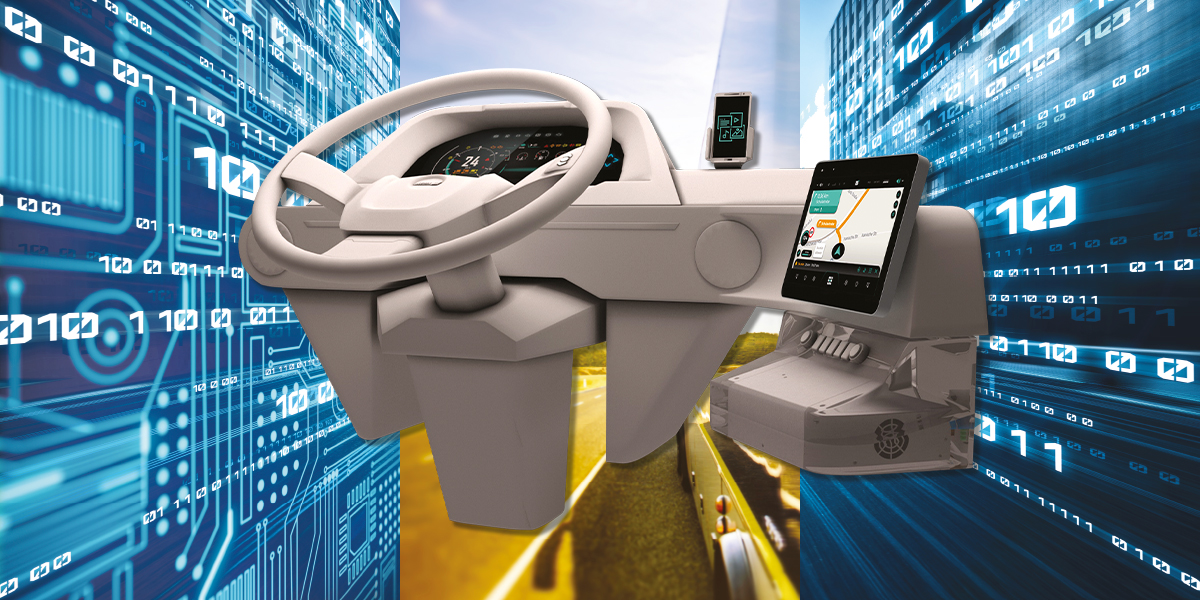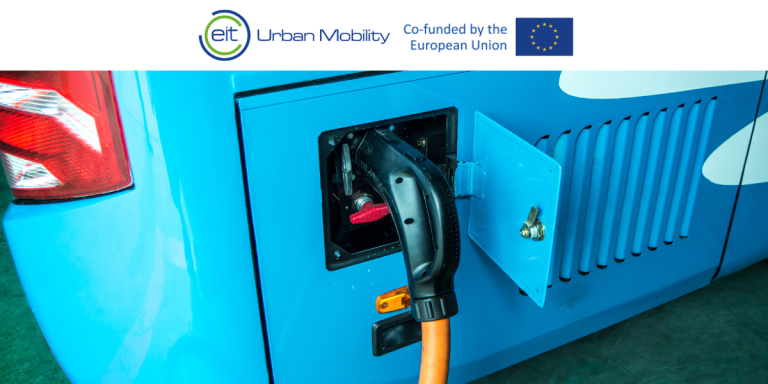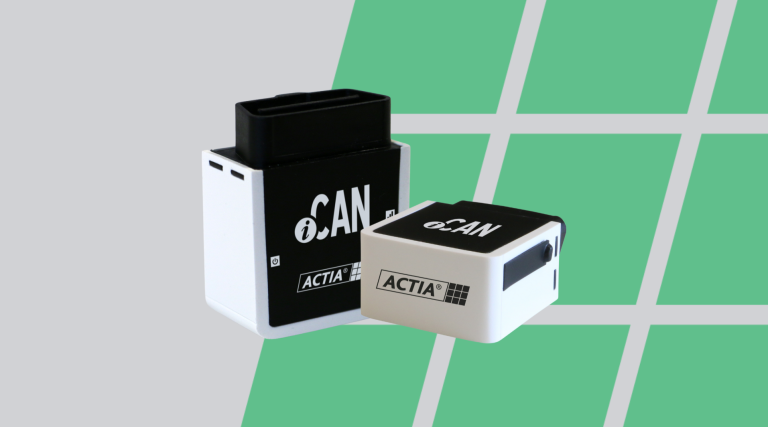As technology advances, driving public transport vehicles is becoming an experience that involves not only the driver, but also the passengers. The key to making this experience positive lies in the digital cockpit. At the most recent FIAA trade fair in Madrid, ACTIA’s design UI experts presented their digital cockpit prototype for buses and coaches. With a focus on this PoC, which sparked a great deal of interest from both drivers and manufacturers, they discussed the latest trends in the driving arena, the challenges that they pose for equipment manufacturers and vehicle manufacturers, and ACTIA’s role in creating future driving experiences.
Learn more from our two experts about ACTIA’s UI approach for the cockpit of the future. Philippe Boutonnet, System solutions product group manager, Electronic vehicle architecture SBA. Sylvain Léon, ACTIA Systems Managing Director.
*User Interface **Proof of Concept
The PoC: reconstruction of driving experiences
The aim of this PoC is to place the driver in a real driving situation. ACTIA has created a digital cockpit. This connected system links three systems in a single solution around the steering wheel: a MultiC FSX intelligent display unit, an Activision touch screen, and an ActiVi central infotainment and on-board systems management unit. The information is synchronised between the different systems.
“We have reproduced various events that drivers encounter in their day-to-day driving such as:
- Fuel alerts,
- Telephone calls,
- Error messages,
- Information about the charge status for electric buses,
- Diagnostic messages such as vehicle overheating,
- Navigation information,
- etc.
The driver is able to browse through the various scenarios offered using the steering wheel buttons. ACTIA’s digital cockpit makes a positive contribution to each stage of the driver’s journey in the system, because the solution shares the user interface in the centre of their field of vision.
It provides the driver with additional coherent information about:
- Vehicle health,
- Driving behaviour,
- On-board comfort information.
Priority information is displayed in a simplified way on the central screen according to the driving route. The interface is uniform with a single design code for the whole solution” explains Sylvain Léon.
ACTIA’s UI approach: focused on the driver
“When designing its digital cockpit, an ongoing concern for ACTIA has been knowing how we should address technology trends, bearing in mind the user experience: even if this seems obvious.
During the design phase, the challenge for ACTIA’s UI designers lies in selecting the information to be displayed: where, when and how it is presented, without cluttering the screen. This means reducing the driver’s cognitive load.
We have a number of technological options, and this brand new technology is exciting for ACTIA engineers, but what counts is the way in which the concept helps drivers in their day-to-day work: carrying out crucial driving tasks, managing the on-board experience, maintaining their vehicle, etc.
This is why it’s not a case of just adding features or visuals simply to satisfy the aesthetic aspect, though this too is important for the user experience, but above all it involves adding value and focusing on how drivers can benefit, through improvements to equipment and displays in particular.
At ACTIA we are opting for a simple approach, especially in dealing with critical elements related to the safety of people or the integrity of the vehicle. Drivers need the information to be displayed on the screen clearly and at the right time,” explains Philippe Boutonnet.
Reducing the driver’s cognitive load
“The role of bus and coach drivers is changing, they have to manage an increasing number of parameters in addition to driving. They have multiple sources of information to do their job: ensuring the safety of passengers and other road users, maintaining their vehicle, dealing with traffic, selling tickets, and sometimes even serving as a guide to users.
As a result, in recent years we have seen endless variations of screens in the cockpit area: on the cluster, above the dashboard or on the sides, on the windscreen (head-up display). There are also significant variations in screen configurations within a single range of vehicles or a brand.
Designing for this kind of screen diversity as well as multimodal controls (manual and touch-sensitive) creates unprecedented complexity for an equipment manufacturer such as ACTIA. This is why we are considering a more minimalist approach to the dashboard, with our digital cockpit.
This cockpit should standardise the user experience across all the vehicle screens. ACTIA is looking to maintain consistency of appearance, user-friendliness as well as ergonomics. Our digital cockpit can still be customised, depending on the brand, while reducing the driver’s cognitive load so that they focus on their tasks. The digital cockpit offers increased opportunities for creatively resolving driving issues,” comments Sylvain Léon.
Readability and accessibility of information
“The intelligent cockpit creates a unique driving experience. ACTIA’s approach to UI aims to help drivers in all their tasks, delivering information in the clearest, most relevant way possible,” explains Philippe Boutonnet.
“Advanced HMIs allow users to interact with vehicles in the most intuitive way possible. New features mean that driving is safer, distraction-free and comfortable. The icons add a human touch to the user interfaces. They make a connection between the driver and the vehicle,” adds Sylvain Léon.
ACTIA’s digital cockpit for manufacturers
“In order to design futuristic driving experiences, bus and coach manufacturers must maintain a long-term perspective. It is currently rather difficult for them to reduce vehicle costs while offering the ultimate user experience.
There is therefore no simple answer: the technological requirements of new features create the need for equipment that is dynamic and scalable; while additional features make their way into vehicles, the equipment needs to be functional not only today, but also in more than 10 years’ time.
The digital cockpit is a winning asset, because it offers huge potential for improving the user experience for drivers, quickly, at low cost and in a scalable way.
This is because information delivered with the right message in the right place is implemented much more quickly than if a feature had to be redesigned at great expense. This is a major competitive advantage on the market for passenger transport vehicles,” specifies Sylvain Léon.
“The platform developed by ACTIA not only contributes to a positive user experience, but also offers a lot of potential in terms of cost efficiency, customisation, and scalability for the manufacturer.
However, manufacturers expect more than just a reduction in costs. They are also looking to provide a driving experience that defines their brand’s identity. Vehicle manufacturers want to offer a holistic driving experience that is in line with their brand and is, above all, unique.
This is the entire role of our“Right Info Time” graphical framework which allows the digital cockpit to be customised quickly and at low cost. This software infrastructure is specially designed for the bus and coach market. It offers an HMI application that is ergonomically optimised for the driver along with typical events, an ergonomic design adapted to the cluster, an application adapted to different vehicle drive units, etc. Several screens can be customised with predefined areas for each of the vehicle’s operating phases. ACTIA’s digital cockpit falls within our “Design to Cost” offer for manufacturers and it also improves the vehicle Time to Market,” adds Philippe Boutonnet.
Summing up ACTIA’s digital cockpit
“Manufacturing the infotainment system for a bus or coach is a complicated process. It is a constant challenge involving equipment manufacturers, integrators and vehicle manufacturers. Together, we need to explore the latest technologies, test their value in the digital cockpit and develop new tools, while keeping costs under control. Although there are still steps to be taken by both equipment manufacturers and vehicle manufacturers, we saw at the latest FIAA trade show in Madrid that users certainly seem ready,” concludes Philippe Boutonnet.
“Using the digital cockpit could be more natural for the future generations of drivers who are much more at ease with digital interfaces and their key functions through a screen as opposed to physical buttons: this is what we need to bear in mind when designing our cockpits,” adds Sylvain Léon.
With this initial PoC, ACTIA’s experts in display technologies have shown that they are also ready to provide this experience to the world of passenger transport.
Visit ACTiVi website






